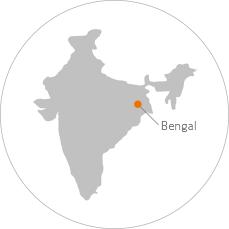Your Cart is Empty
SHOP NOW - 60% OFF ENTIRE SITE - NO CODE NEEDED!
These Jamdani weavers are working hard to keep their craft alive. As the traditional handloom weaving takes place, each design motif is added separately by hand.

Location: Bengal, India
How we Found the Group
When we first met our production partner, Sonica, in her offices in Delhi we were shown dozens of beautifully handcrafted items made by talented artisan communities from various regions in India. We came knowing that we wanted to add shawls to our collection and were fascinated by the Jamdani pieces and the intricacy of the technique. Working through Sonica, we've been able to start a collaboration with this talented community.
The Story
The weaving cooperative we collaborate with has been in existence since the 1950's and is made up of around 100 artisans, of which 60% are men and 40% are women. The women are involved mostly in the many pre-loom processes such as spinning the yarn while the weaving is primarily done by men.
The beauty of Jamdani weaving was recognized by the Mughal emperors and, thanks to their patronage, traditions and knowledge were preserved and passed on through to the generation of present day weavers. Working from their homes, entire village communities in this area of Bengal are involved in the craft of Jamdani.
When we came to understand the lengthy process and the level of patience and skill involved in Jamdani weaving, we were amazed. Unlike some other weaving methods where the design has been "programmed" prior to the start of weaving, what makes Jamdani special is the supplementary weft technique applied to create the design. Watching these artisans working on their handlooms and pausing the weaving process every few seconds to separately weave each line of our motifs into the shawls, is captivating. Each piece created is a true treasure.
Considered the most intricate of Bengali craftsmanship it is sad to know that these artisans’ craft is on the verge of extinction. Working with this cooperative means we are able to make a small contribution to the daily orders they require to be able to sustain this beautiful craft, and sustain their livelihoods. Our production partner has been working with the group since 2014 providing regular training to upgrade their skills to meet the demands of today's markets. Our aim is to help make it possible for future generations to practice this craft as well.